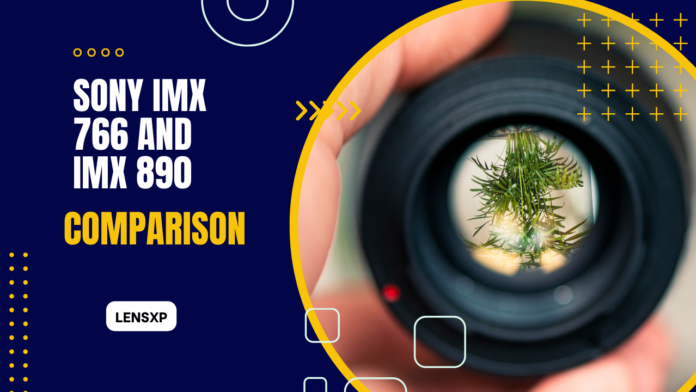Also Read: Comparing Sony IMX866 vs IMX766
Here are just a few of the features that make the IMX 766 vs. IMX 890 sensors unique:
- Large sensor size: The IMX 766 and IMX 890 sensors have a larger sensor size than previous generations, which means they can capture more light and detail. This is especially beneficial for low-light photography and videography.
- More megapixels: The IMX 766 and IMX 890 sensors have more megapixels than previous generations, so you can crop your images more and still get great results. This is also beneficial for printing large photos.
- Improved low-light performance: The IMX 766 and IMX 890 sensors have improved low-light performance, so you can take sharper and more detailed photos in low-light conditions. This is perfect for shooting at night or in dimly lit environments.
- Fast autofocus: The IMX 766 and IMX 890 sensors have fast autofocus, so you can easily capture moving subjects. This is perfect for shooting sports, action, or wildlife photography.
- Video recording: The IMX 766 and IMX 890 sensors can record video in 4K resolution at 60 frames per second, perfect for creating high-quality videos.
Related: IMX989 vs IMX903 vs IMX907
Comparison Table: Sony IMX 766 vs IMX 890 camera sensors:
| Feature | IMX 766 | IMX 890 |
|---|---|---|
| Sensor size | 1/1.56 inches | 1/1.3 inches |
| Pixel size | 1.0μm | 1.22μm |
| Megapixels | 50MP | 50MP |
| ISO range | 100-51200 | 100-102400 |
| Dynamic range | 12.5 stops | 15 stops |
| Autofocus | Phase detection and contrast detection | Phase detection and contrast detection |
| Image stabilization | OIS | OIS |
| Video recording | 8K@30fps, 4K@120fps, 1080p@240fps | 8K@30fps, 4K@120fps, 1080p@240fps |
| Other features | DOL-HDR, Eye AF, Real-time tracking | DOL-HDR, Eye AF, Real-time tracking |
| Price | $15-$20 | $25-$30 |
As you can see, the IMX 890 has a slightly larger sensor size, larger pixel size, higher dynamic range, and a more comprehensive range of video recording features. It also costs slightly more than the IMX 766.
Ultimately, the best camera sensor for you will depend on your needs and budget. If you are looking for the best possible image quality, the IMX 890 is the better choice. However, the IMX 766 is still a great option if you are on a budget.
Sensor size
The IMX 890 has a slightly larger sensor size than the IMX 766. This means it can capture more light, improving image quality in low-light conditions.
Pixel size
The IMX 890 also has a larger pixel size than the IMX 766. Each pixel can capture more light, improving image quality in low-light conditions.
Dynamic range
The IMX 890 has a higher dynamic range than the IMX 766. This means it can capture a broader range of brightness levels in a single image, improving image quality in scenes with much contrast.
Autofocus
The IMX 766 and IMX 890 have phase and contrast detection autofocus. This means they can quickly and accurately focus on subjects, even in low-light conditions.
Image stabilization
The IMX 766 and IMX 890 have optical image stabilization (OIS). This helps to reduce camera shake, which can lead to sharper images.
Video recording
The IMX 766 and IMX 890 can record 8K video at 30fps. However, the IMX 890 can also record 4K video at 120fps, while the IMX 766 is limited to 4K video at 60fps.
Other features
The IMX 766 and IMX 890 have several other features, such as DOL-HDR, Eye AF, and Real-time tracking. These features can help to improve the quality of your images and videos.
Overall
The IMX 890 is a slightly better camera sensor than the IMX 766. It has a larger sensor size, pixel size, higher dynamic range, and broader video recording features. However, it is also slightly more expensive.
Ultimately, the best camera sensor for you will depend on your needs and budget. If you are looking for the best possible image quality, the IMX 890 is the better choice. However, the IMX 766 is still a great option if you are on a budget.
Here are some phones that use the Sony IMX 766 and IMX 890 camera sensors:
Phones with Sony IMX 766
- OnePlus 10 Pro
- Realme GT Neo 3
- Oppo Reno 7 Pro
- Xiaomi 12 Pro
- Poco F4 GT
- Motorola Edge 30 Pro
- iQOO 9 Pro
- Vivo X70 Pro+
- OnePlus 9RT
- Realme GT 2 Pro
Phones with Sony IMX 890
- Realme GT Neo 3T
- Oppo Reno 9 Pro+
- Xiaomi 12S Pro
- Redmi K50 Pro
- Motorola Edge 30 Ultra
These are just a few phones that use the Sony IMX 766 and IMX 890 camera sensors. If you are looking for a phone with a great camera, these are some of the best options.
Conclusion
The Sony IMX 766 and IMX 890 sensors are the perfect choice for photographers and videographers who demand the best image quality. With their large sensor size, more megapixels, and improved low-light performance, these sensors will surely deliver stunning images in any lighting condition.
If you are looking for a camera sensor that can take your photography and videography to the next level, then the Sony IMX 766 and IMX 890 sensors are the perfect choice.

